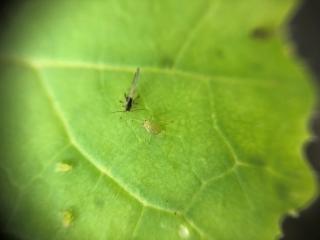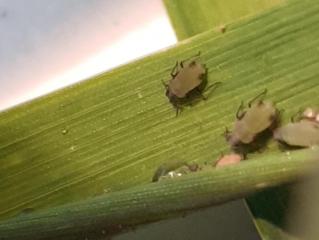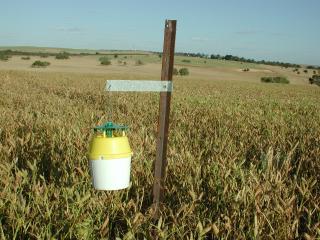Cereal aphids
- Woorree (Geraldton)
Technical officer Anne Smith (DPIRD) has found corn aphids in a barley trial at Woorree (near Geraldton). The barley was at the stem elongation growth stage.
The two main cereal aphids in WA are corn aphids and oat aphids.
Corn aphids are light green to dark olive green with darker patches at the base of the tube –like projections (siphuncles) on either side at the rear of the body.
Corn aphid colonies are often difficult to detect because they usually develop within the furled leaves of tillers any time from seedling to head emergence.
Oat aphids are the most abundant species of cereal aphids and vary from mottled yellow-green through olive-green and dusky brown, to a blackish green and are characterised by a reddish patch on the tip of the abdomen.
Oat aphid colonies develop on the outside of tillers from the base upwards on stems, nodes and backs of mature leaves, starting any time between seedling stage and grain filling.
Cereal aphid adults and nymphs suck plant sap with large populations limiting grain yield and size, especially with winter and spring infestations. Cereal aphids also spread barley yellow dwarf virus that reduces cereal yield.
It is also important that growers and consultants continue to monitor WA cereal crops for the Russian wheat aphid (RWA). This pest has not been found in WA. In addition to feeding damage it can inject toxins into cereal plants further stunting them and reducing yields. For more information on RWA refer to the department’s Diagnosing russian wheat aphid and Biosecurity alert - Russian wheat aphid pages. For more tips on how to identify RWA view cesar’s Russian wheat aphid identification video.
Growers and consultants can use the PestFax Reporter app to request or confirm identification of aphids found in crops.
For a list of insecticides registered for use on aphids see the department’s 2020 Winter Spring Insecticide Guide.
For more information on cereal aphids refer the department’s Diagnosing cereal aphids page and 2017 Protecting WA Crops Issue 3 newsletter Aphids – WA’s insect problem children.
For more information on aphids contact Svetlana Micic, Research scientist, Albany on +61 (0)8 9892 8591 or Alan Lord, Technical officer, South Perth on +61 (0)8 9368 3758.
Article author: Cindy Webster (DPIRD Narrogin).
Green peach aphid and turnip yellows virus update
- Northam
- Albany
- Condingup

Plant virologist Dr Benjamin Congdon (DPIRD) reports that there is a Green peach aphid (GPA) and turnip yellows virus (TuYV) hotspot west of Condingup. This area could be at high risk for further virus infection in the next couple of months, especially if there are vulnerable late canola crops in the area.
Ben’s sticky trap surveillance is also currently indicating that there is some TuYV but very low numbers of GPA in the Albany port zone. There are also low numbers of GPA being captured in Northam, but very little GPA activity in Toodyay, Mullewa and Mingenew.
For more information on TuYV refer to DPIRD’s Managing turnips yellows virus in canola page.
If you do identify GPA in your crop, monitor and only spray if seedling crops are moisture stressed and/or have high numbers of GPA on the plant so the plant is unable to outgrow GPA feeding damage.
Australian GPA populations are known to have resistance to four different chemical groups – synthetic pyrethroids (for example, alpha-cypermethrin), organophosphates (for example, dimethoate), carbamates (for example, pirimicarb) and neonicotinoids. For more information refer to GRDC’s Resistance Management Strategy for the Green Peach Aphid in Australia Grains.
Growers are reminded to contact Dr Paul Umina (cesar) on +61 (0)3 9349 4723 if you see aphids survive a Transform™ application.
For a list of insecticides registered for use on aphids see the department’s 2020 Winter Spring Insecticide Guide.
Growers and consultants can use the PestFax Reporter app to request or confirm identification of aphids found in crops.
For more information on identifying and managing canola aphids see DPIRD’s;
- 2020 PestFax Issue 5 article Aphid activity update
- Aphid management in canola crops page
- Diagnosing canola aphids page
- 2017 Protecting WA Crops Issue 3 newsletter Aphids – WA’s insect problem children
- Aphids in your crops YouTube video.
For more information on TuYV contact Dr Benjamin Congdon, Research scientist, South Perth on +61 (0)8 9368 3499.
For more information on aphids contact Svetlana Micic, Research scientist, Albany on +61 (0)8 9892 8591 or Alan Lord, Technical officer, South Perth on +61 (0)8 9368 3758.
Article author: Cindy Webster (DPIRD Narrogin).
Weekly native budworm moth trapping has begun early for some WA locations
- Binnu
- Kirwan
- Dalwallinu
Some volunteer farmers, agronomists and Department of Primary Industries and Regional Development (DPIRD) staff have commenced weekly pheromone trapping for native budworm moths during the past week.
The trapping has started earlier than previous years due to weather events encouraging populations of moths to arrive early. This was backed up by recent reports to PestFax of high moth and caterpillar numbers in some northern wheat belt areas.
This trapping is part of a program to monitor the annual native budworm migratory flights from eastern pastoral areas into the grainbelt and the potential risk of caterpillars to pulse and canola crops.
There was a large flight of budworm moths into the Binnu area this week with the trap there catching 313 moths. This follows 173 moths caught in the previous week.
Other notable captures this week include; Kirwan (144 moths) and Dalwallinu (64 moths).
Results of this week's automated and manual trappings are available at the department’s Native budworm moth numbers 2020 and this table will be updated weekly as new trapping results come in.
A mapped view of the native budworm trap captures is available at cesar’s MothTrapVisWA page. Viewers need to select the budworm species name (H. punctigera) from the drop down menu as well as the current year and desired trapping date range.
Pesticide options for the control of native budworm and DBM can be found in DPIRD’s 2020 Winter Spring Insecticide Guide.
Detailed information on native budworm can be found at DPIRD’s Management and economic thresholds for native budworm page and 2020 PestFax Issue 7 article Native budworm and other moths are active.
For more information contact Alan Lord, Technical Officer, South Perth +61 (0)8 9368 3758 or +61 (0)409 689 468.
Article author: Alan Lord (DPIRD South Perth).


